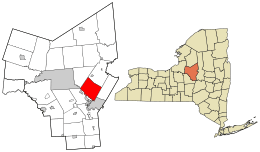Marcy, New York facts for kids
Quick facts for kids
Marcy, New York
|
|
|---|---|

Location in Oneida County and the state of New York.
|
|
| Country | United States |
| State | New York |
| County | Oneida |
| Government | |
| • Type | Town Council |
| Area | |
| • Total | 33.32 sq mi (86.29 km2) |
| • Land | 32.89 sq mi (85.18 km2) |
| • Water | 0.43 sq mi (1.11 km2) |
| Elevation | 827 ft (252 m) |
| Population
(2020)
|
|
| • Total | 8,777 |
| • Density | 286.11/sq mi (110.47/km2) |
| Time zone | UTC-5 (Eastern (EST)) |
| • Summer (DST) | UTC-4 (EDT) |
| ZIP code |
13403
|
| Area code(s) | 315 |
| FIPS code | 36-45535 |
| GNIS feature ID | 0979197 |
| Website | Town of Marcy, NY |
Marcy is a town located in Oneida County, New York, in the United States. In 2020, about 8,777 people lived there. It was named after William L. Marcy, who was a governor. Marcy is found between the cities of Rome and Utica. The famous Erie Canal runs through the southern part of the town.
Marcy is also home to SUNY Polytechnic Institute, a university where students can study for four years. This school is in the southeastern part of the town.
Contents
History of Marcy
The very first settlers arrived in the area around 1773. During the American Revolutionary War, these early settlers had to leave their farms. A friendly Oneida Indian warned them about an enemy attack. They returned to their homes after the war ended, in 1792.
The Town of Marcy was officially created in 1832. It was formed from a part of the Town of Deerfield, which is located to the east. In 1920, the population of Marcy was 1,919 people.
An important historical site, the Neck Canal of 1730, was added to the National Register of Historic Places in 1995.
Exploring Marcy's Geography
Marcy covers a total area of about 33.4 square miles (86.29 square kilometers). Most of this area, about 33.0 square miles (85.18 square kilometers), is land. The remaining 0.4 square miles (1.11 square kilometers) is water.
The Mohawk River forms the southern border of the town. This river is a natural landmark.
Major roads also pass through Marcy. The New York State Thruway (Interstate 90) goes through the southeastern part of the town.
The Erie Canal, also known as the Barge Canal, runs through the southern end of Marcy. You can find Lock 20 Canal Park along the canal, just east of the Route 291 bridge.
SUNY Polytechnic Institute is located on a large campus of 700 acres. It is northwest of where the North-South Arterial (NY 8 and NY 12) meets NY 49.
Marcy's Population and People
In 2020, the town of Marcy had a population of 8,777 people. Back in 2000, there were 9,469 people living in the town. At that time, there were 2,003 households. A household is a group of people living together in one home.
About 33% of these households had children under 18 years old. Most households, about 65.5%, were married couples living together. The average household had 2.60 people.
The population in Marcy was spread out across different age groups. About 13.2% of the people were under 18 years old. About 8.5% were 65 years or older. The average age in Marcy was 36 years.
Communities and Locations in Marcy
Marcy is home to several smaller communities and important places:
- Careys Corners – This was once a small community in the southern part of town, near the Erie Canal. It no longer exists as a separate place.
- Marcy – This is the main hamlet, or small village, within the southern part of the town.
- Marcy Correctional Facility – This is a state prison located close to the hamlet of Marcy.
- Marcy Hill – This is a higher area of land located north of Utica.
- Maynard – Another small community found in the southeastern part of the town.
- Mid-State Correctional Facility – This is another prison located near Marcy.
- Stittville – A small community in the northwestern corner of the town.
- Frederick R. Clark Energy Center – This is a facility of the New York Power Authority.
Education in Marcy
Most of the town of Marcy is part of the Whitesboro Central School District. This means that many students in Marcy attend schools within this district. Other parts of the town are served by the Holland Patent Central School District and the Oriskany Central School District.
Notable People from Marcy
- Rouse Simmons, who was a politician and businessman in Wisconsin, was born in Marcy.
- Rufus J. Dryer, a modernist painter, passed away in Marcy.
See also
 In Spanish: Marcy (Nueva York) para niños
In Spanish: Marcy (Nueva York) para niños

